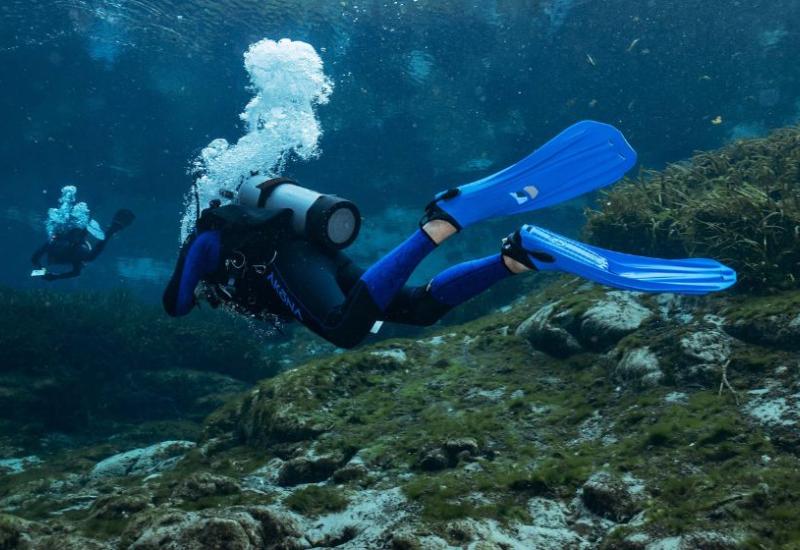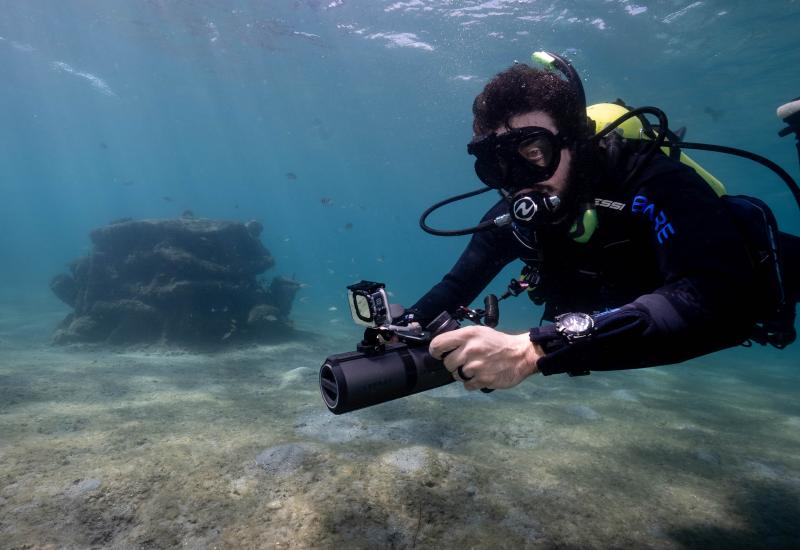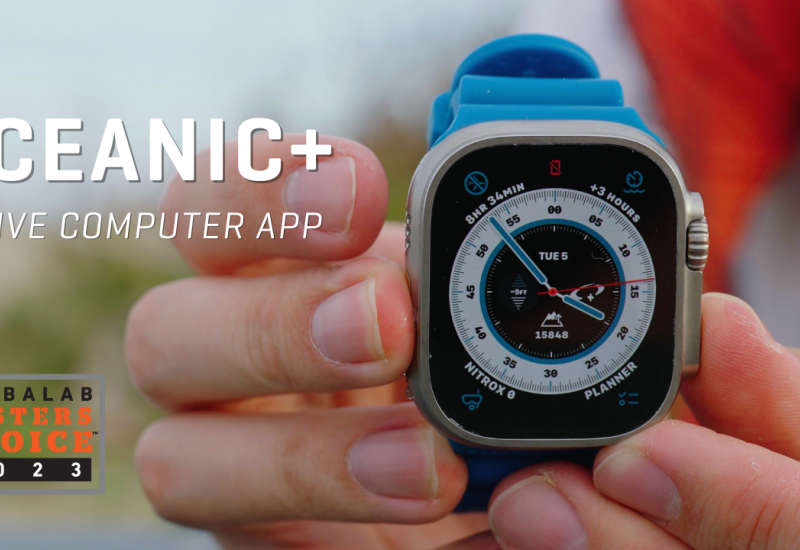18 Brand-New Dive Knives Tested By ScubaLab
You want a dive knife that is sharp, strong and resistant to corrosion. We tested 18 brand-new knives to find out which ones have the edge.
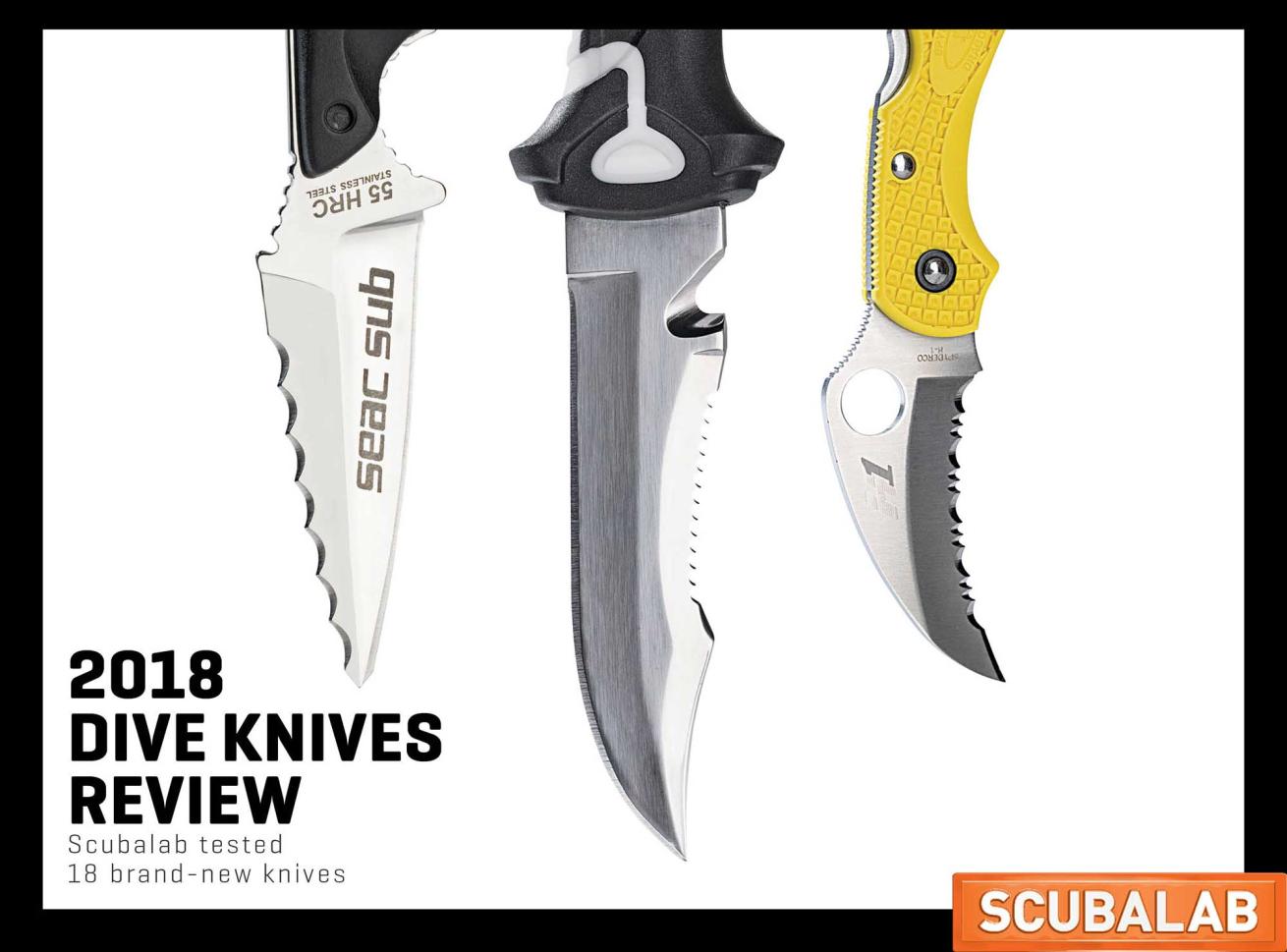
Jon WhittleScuba Diving Magazine's ScubaLab tested 18 new dive knives, read the results and reviews here to see the best new knives on the market.
HOW WE TEST
Our test was designed to gauge each knife’s cutting ability, ergonomics and suitability for dive use, and its durability and corrosion resistance.
Cutting Ability
We tested each knife’s ability to cut through handheld loops of four materials: heavy duty (.095-inch) plastic trimmer line; ¼-inch hollow polypropylene; ¼-inch diamond braid polypropylene; and ½-inch threestrand, twisted polypropylene.
We chose these lines because they’re typical of the materials in the lines and nets encountered by divers and left to deteriorate in the ocean.
If a knife was able to cut a line in a single pass, a double-thickness was attempted. After all four lines were cut, the knife was used to make 20 repetitive cuts, then the four cuts were attempted again to determine whether the blade had lost any of its edge.
The knives were also used to cut multistrand copper electrical cord, heavy nylon zip ties, and other materials. The cuts weren’t scored but gauged strength and ability to withstand abuse.
Ergonomics
Knives were scored for performance of sheaths, locks and grips:
- Security of sheath or lock
- Ease of removing and replacing from sheath (with and without gloves)
- Security/comfort of grip when cutting
- Feel, fit and finish
Durability
This test included two parts designed to determine a knife’s resistance to breaking and rusting.
Pry test: The knife’s blade was inserted 1-inch into a block of wood, and a 10-pound scuba weight was hung from the end of the handle to evaluate the knife's strength.
Corrosion resistance: This was intended to replicate a day of ocean diving followed by gear maintenance, as well as situations where rinsing is delayed. Knives were submerged in salt water for six hours, then rinsed in fresh water, disassembled if possible, and dried.
Next, the knives were submerged and left in salt water for 24 hours, then rinsed, disassembled, and dried.
HOW WE SCORE
We turned these knives loose on an assortment of materials (see How We Test).
Cuts were scored as follows:
5 = Very easy to cut in one pass
4 = Easy to cut in one pass
3 = Possible to cut in one pass
2 = Required multiple passes to cut
1 = Very difficult to cut
Click here to download the full test scores in all categories.
FULL
OVER 8 INCHES
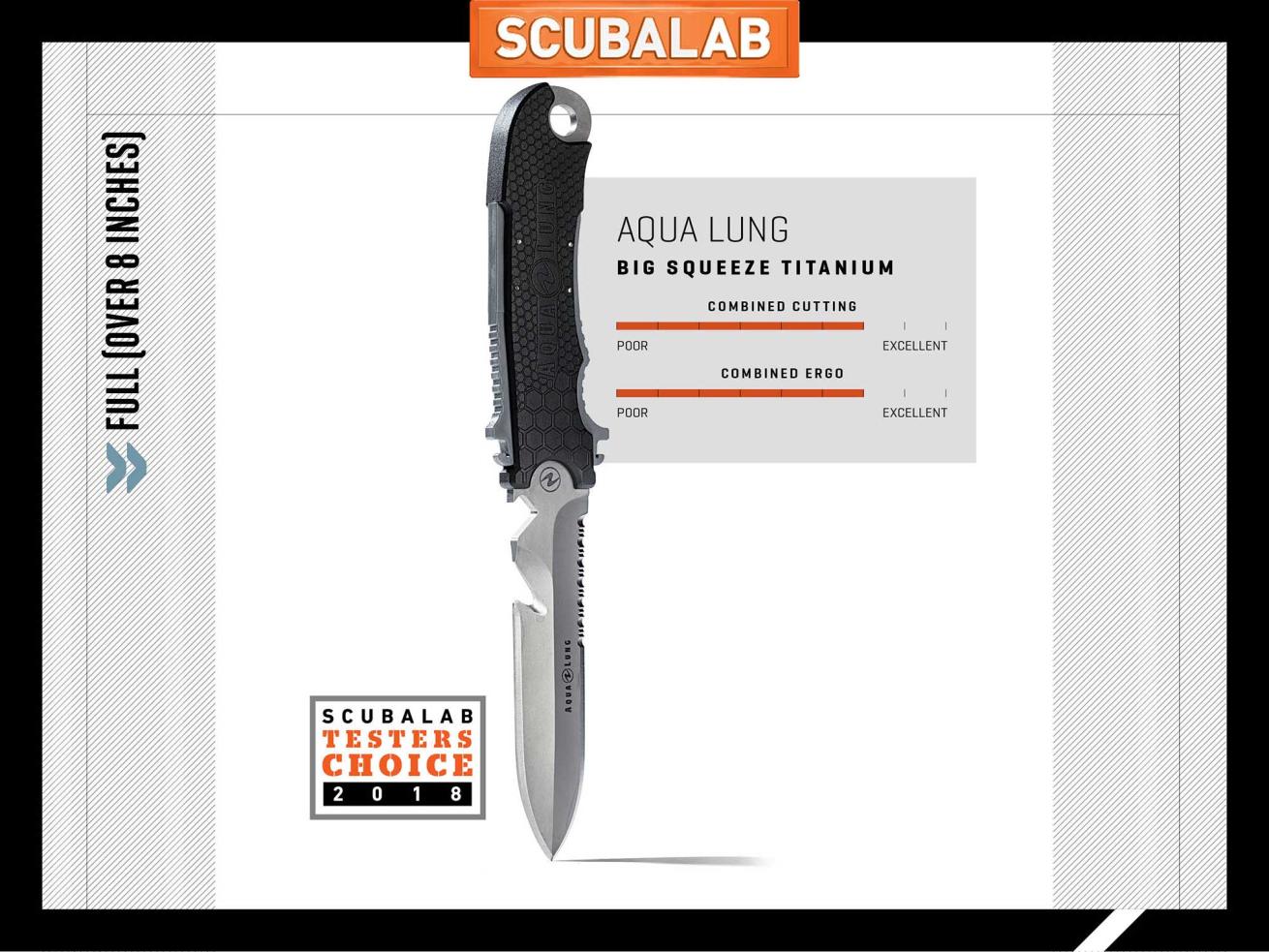
Jon WhittlePrice: $100 Contact: Aqua Lung
The big boy in Aqua Lung’s Squeeze line is also available in stainless, but we tested the titanium version because we wondered if its cutting ability would disappoint us the way so many nicely made Ti knives have in the past. It did not. Its 4¼-inch spear-tip blade with smooth and serrated edges took the highest overall cutting score of any titanium knife in our test, and tied the best score for any knife in cutting stubborn heavy monofi lament.
“Cuts like a steel knife,” one tester noted, but unlike steel, it emerged from the saltwater tank without a stain. As with the other sizes of Squeeze knives, its sheath and lock mechanism were rated excellent for security and functionality, and the only gripe was the way the lock tab digs a little if you grip the handle with your thumb on the back. Eager to cut, impervious to corrosion and made to last, the Big Squeeze Titanium is our Testers Choice for full-size knives.
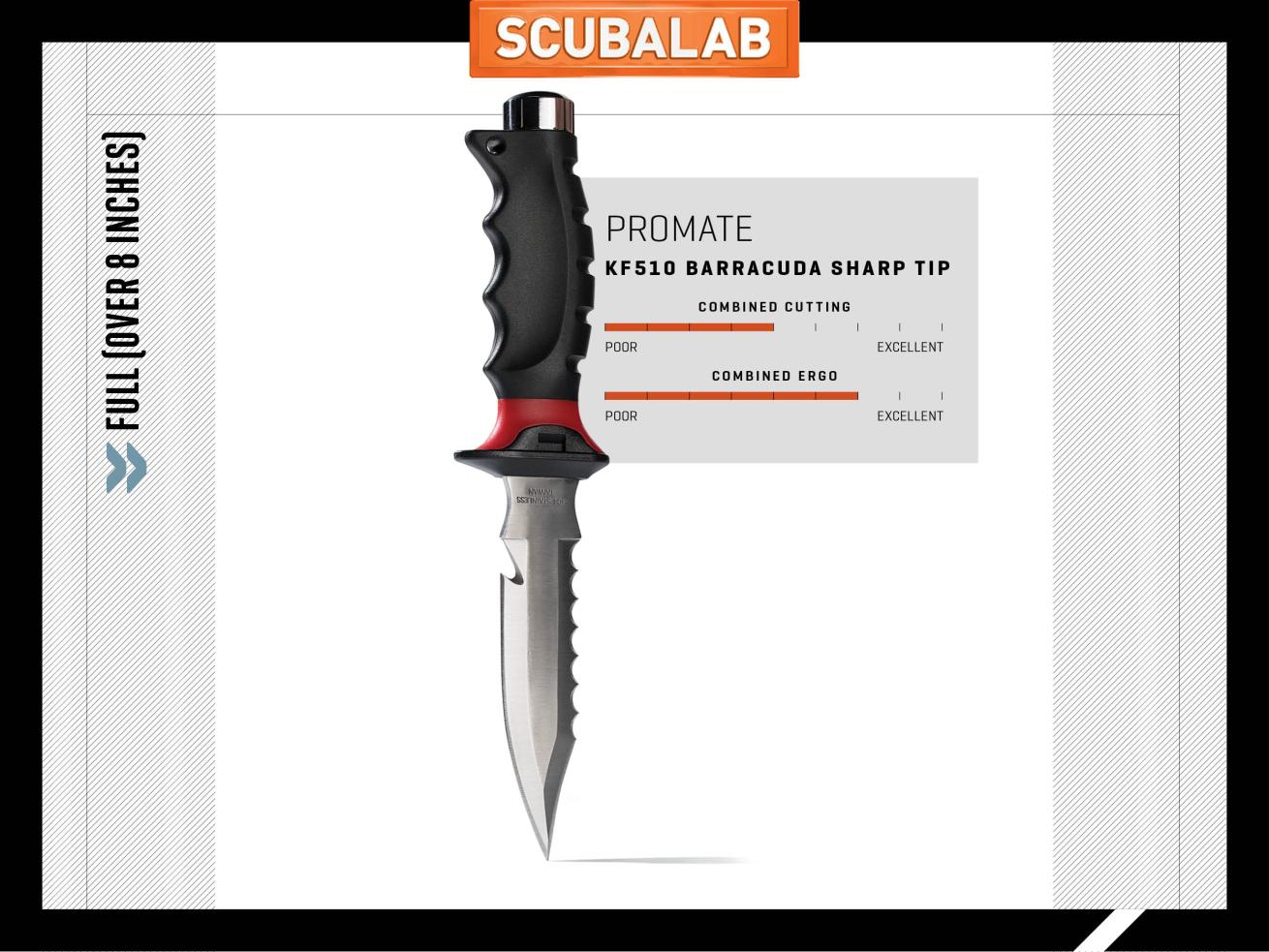
Jon WhittlePrice: $59 Contact: Promate
One of the largest knives in our test, the Barracuda is a full 10 inches overall. But because of the blade’s design, with a long unsharpened base and line cutter at the bottom, the curved cutting edge is just about 3¾ inches. That hurt it a bit in our cutting test because the line cutter tended to hang up on heavier line. And while the serrated edge along the back cuts well, the handle’s ergonomic fingergroove design, which is secure and comfortable otherwise, doesn’t lend itself to holding backward. Made of thick 304 stainless and rugged enough to hammer and pry all day, it disassembles quickly by unscrewing the heavy steel butt. After 24 hours in salt water, it cleaned up like new. The sheath is secure and quick to release, but given the knife’s size, it requires quite a bit of calf to mount.
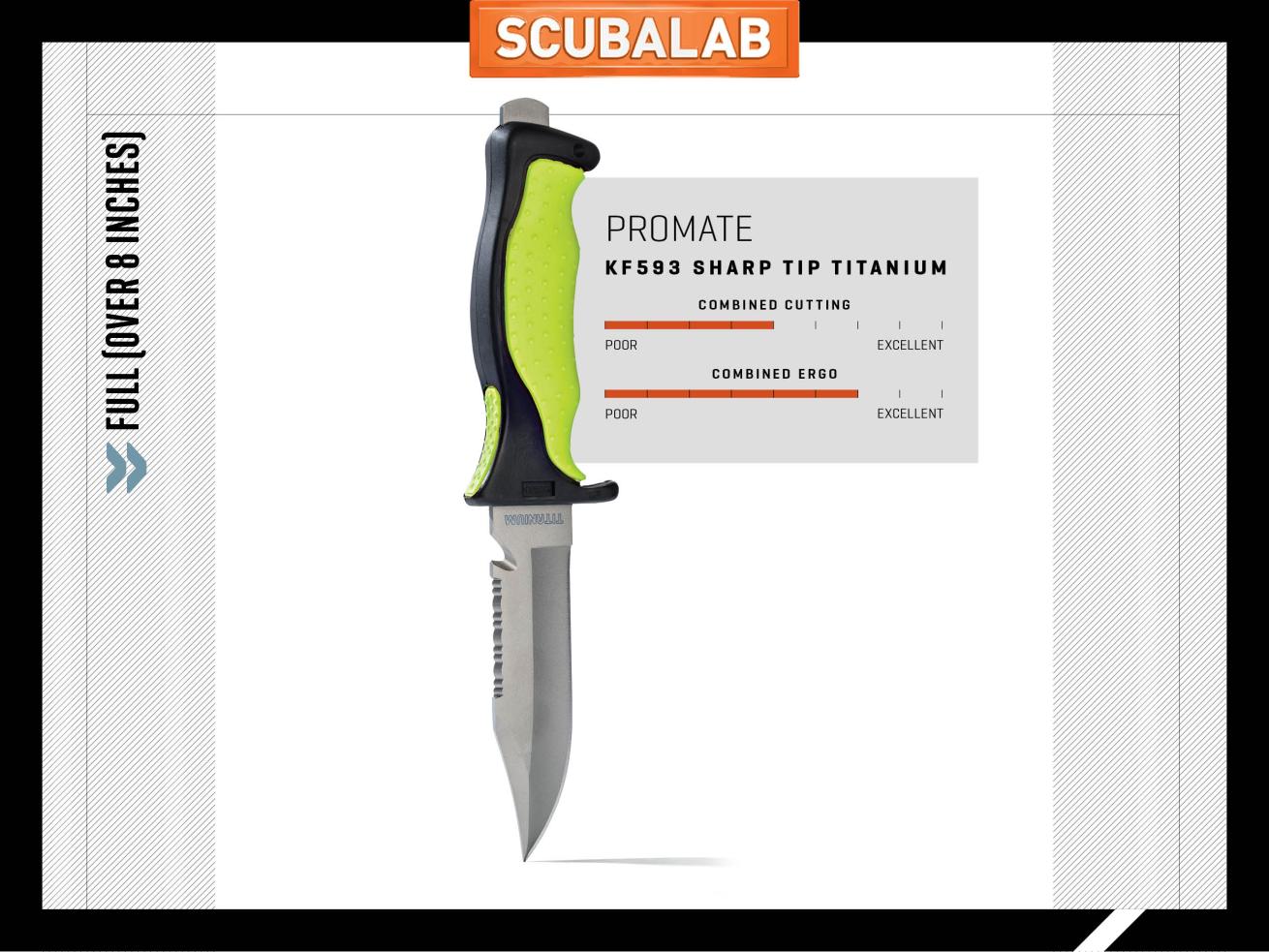
Jon WhittlePrice: $99.95 Contact: Promate
Though it’s a half-inch shorter than Promate’s steel model, the Sharp Tip Titanium actually has a slightly longer effective cutting edge because of the line cutter’s location at the base of the serrated section on the back. That helped the knife take a very good overall score for cutting ability, with a sharp edge that sliced aggressively and didn’t lose any of its bite until after many repetitive cuts of heavy material. The blade tang extends through the overmolded handle to make a useful tank knocker, and the soft, rubbery sections of the grip make it easy and comfortable to hold with or without gloves. The sheath is secure if the knife is fully inserted, but if you don’t get it all the way in, it can catch on the outer part of the latch and not hold securely, which hurt its score.
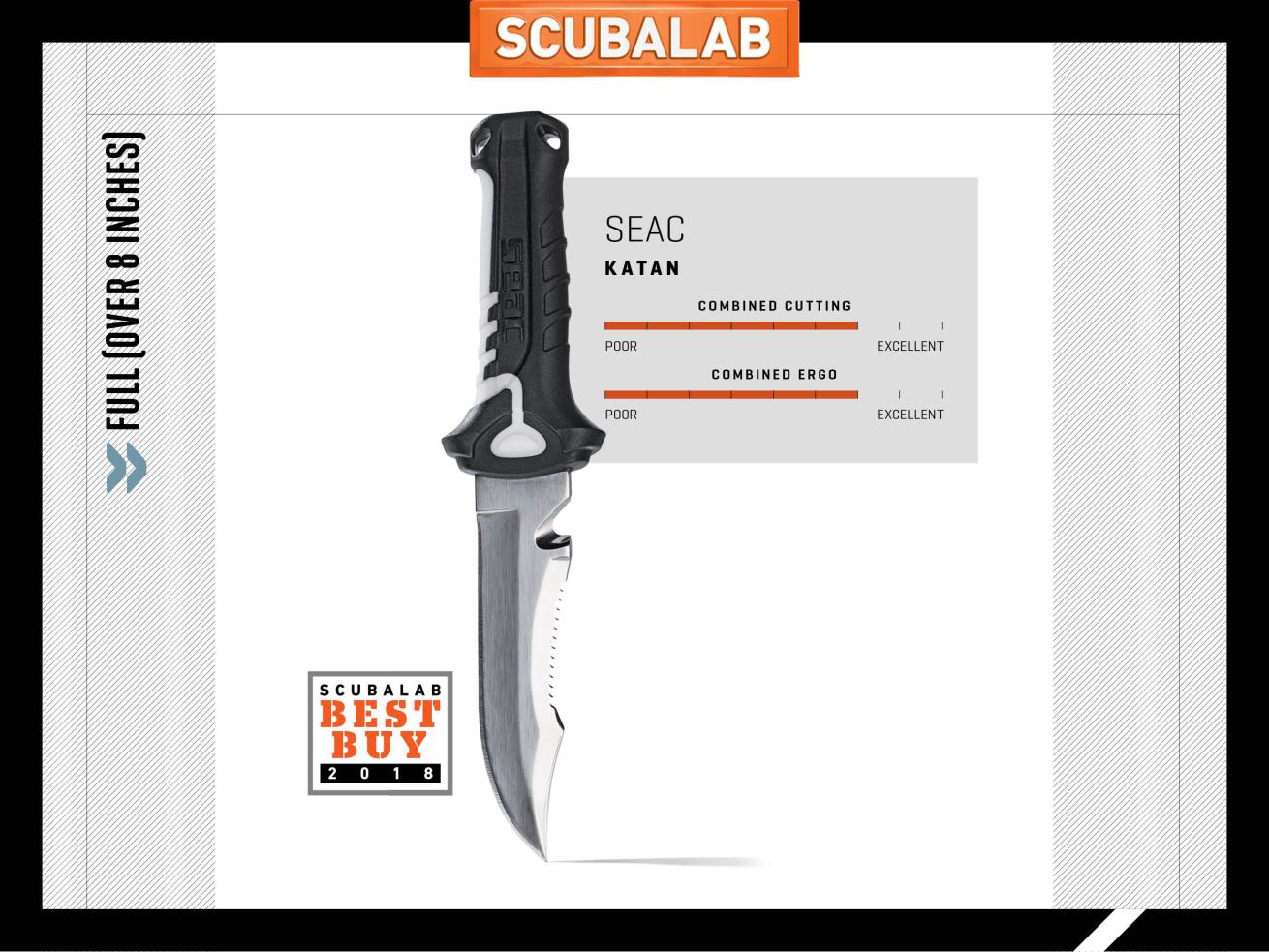
Jon WhittlePrice: $49 Contact: Seac
The design of the Katan gives the maximum length to the real working edge of the blade, which helped it make short work of all materials and earn the second-highest cutting score in its category. The sturdy 420 stainless blade cut as well at the end of the test as at the beginning, but it was also quick to rust. We cleaned off most of the corrosion accrued after our 24-hour soak, but it took some effort to restore its chromelike luster. The Katan rattles a bit in the sheath, but only the most determined diver could yank it out without unlocking it. The bare-bones handle is straight and hard but not uncomfortable. It offers a good grip both ways, perfect for utilizing the blade’s serrated edge. For impressive performance far below the average price, the Seac Katan is our Best Buy.
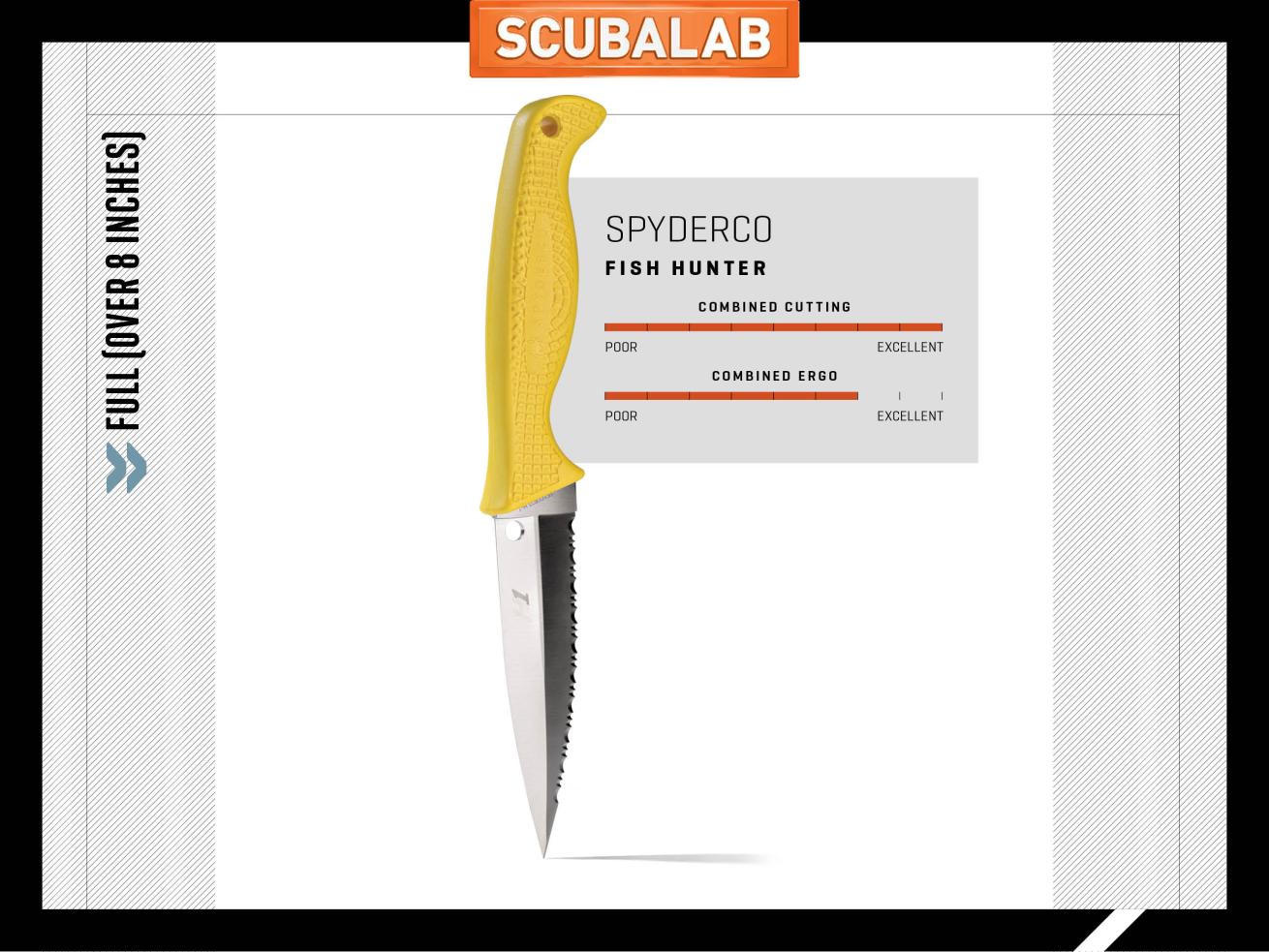
Jon WhittlePrice: $174.95 Contact: Spyderco
Even if the name didn’t give it away, it’s easy to spot the Fish Hunter’s freediving/spearfishing focus. With 4 inches of serrated edge, that thin, penetrating blade of H1 steel cut like crazy, taking the top combined cutting score of any knife in our test, nearly slicing through a double thickness of half-inch line in one pass, and holding its edge throughout. The handle’s waffle texture and ergonomic shape make for a secure grip. In our scuba oriented scoring, two things that are pluses for a spear knife worked against it: the snap-fit lock on the sheath, which allows instant release but not a sure lock, and the lethal blade design, which would quickly dispatch a fish but makes it tough to use in touchy spots without accidental cuts. But for a well-made, corrosion-free spear knife, look no further.
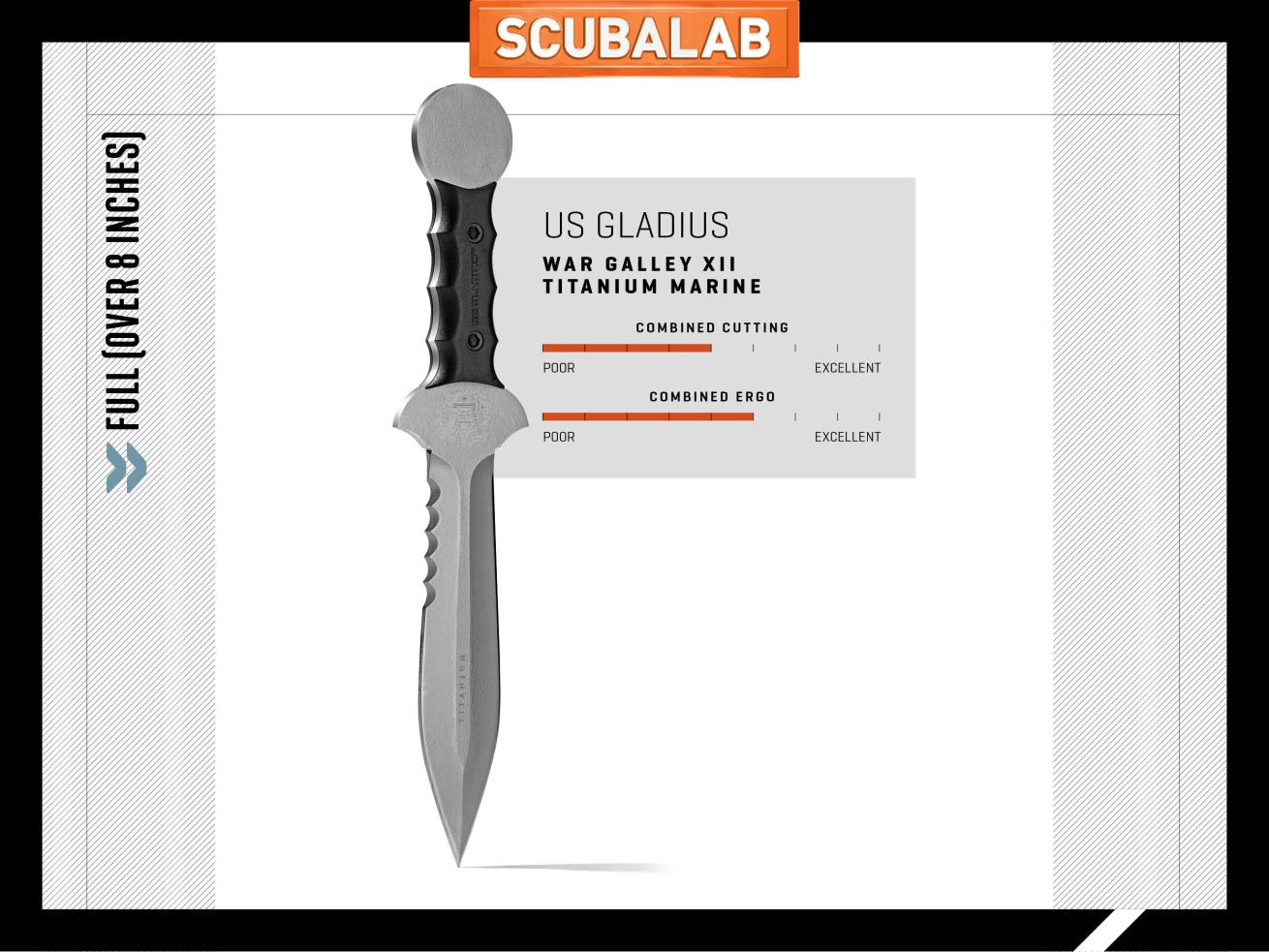
Jon WhittlePrice: $195 Contact: U.S. Gladius
Sure to raise some eyebrows on the dive boat, the War Galley XII’s 6½-inch blade was the largest in our test. Its design provides a long stretch of uninterrupted cutting surface, free of serrated edges and line cutters that would otherwise snag. That helped it earn good and very good scores for the softer lines, but it struggled with tougher stuff. The blade proved to be quite strong during our pry test, which is impressive given its length. The sheath is reasonably secure, but its basic design seems at odds with the gladiatorial short sword it carries. The titanium blade was unmarred in our corrosion test. The War Galley’s grip ends in a large pommel that can be used for striking and hammering — perfect for a knife that could take on the kraken.
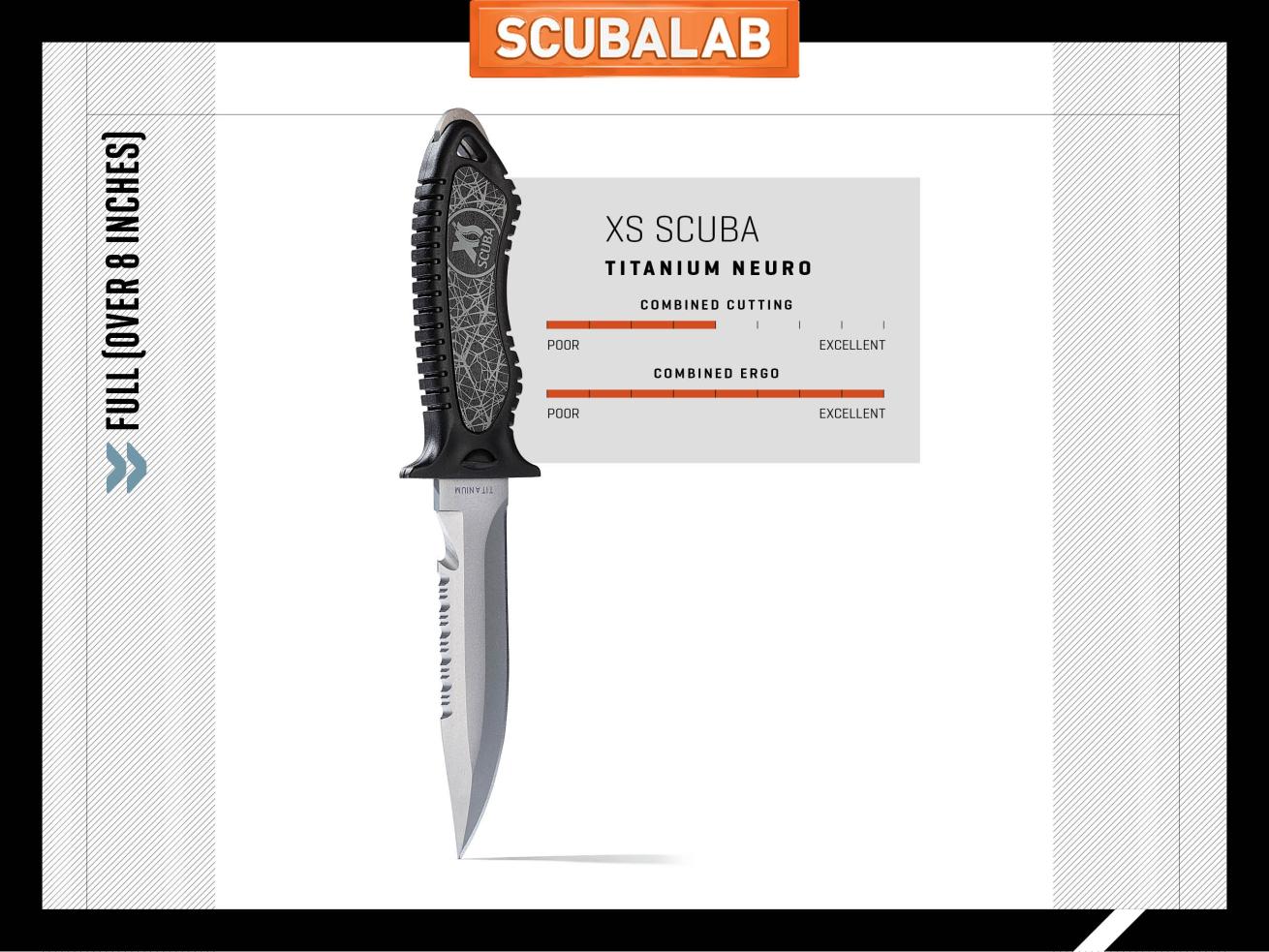
Jon WhittlePrice: $110 titanium, $45 stainless steel Contact: XS Scuba
The Neuro earned the highest ergonomic score in the test. We were impressed by its secure sheath — which allows for one-handed replacement of the knife — and its overall construction. But what really blew us away was the handle. It’s nothing fancy, but the well-placed grooves and curves allowed for a solid and comfortable grip. The 4½-inch blade proved to be strong, although a bit springy, in our pry test. The Neuro cuts like a typical titanium blade, with some trouble getting through the monofilament and twisted polypropylene, but otherwise earning average and good scores on softer lines. After sitting in seawater for a day, salt buildup was visible where the blade meets the injection-molded handle, but of course there was no corrosion.
MEDIUM
6.5 TO 8 INCHES
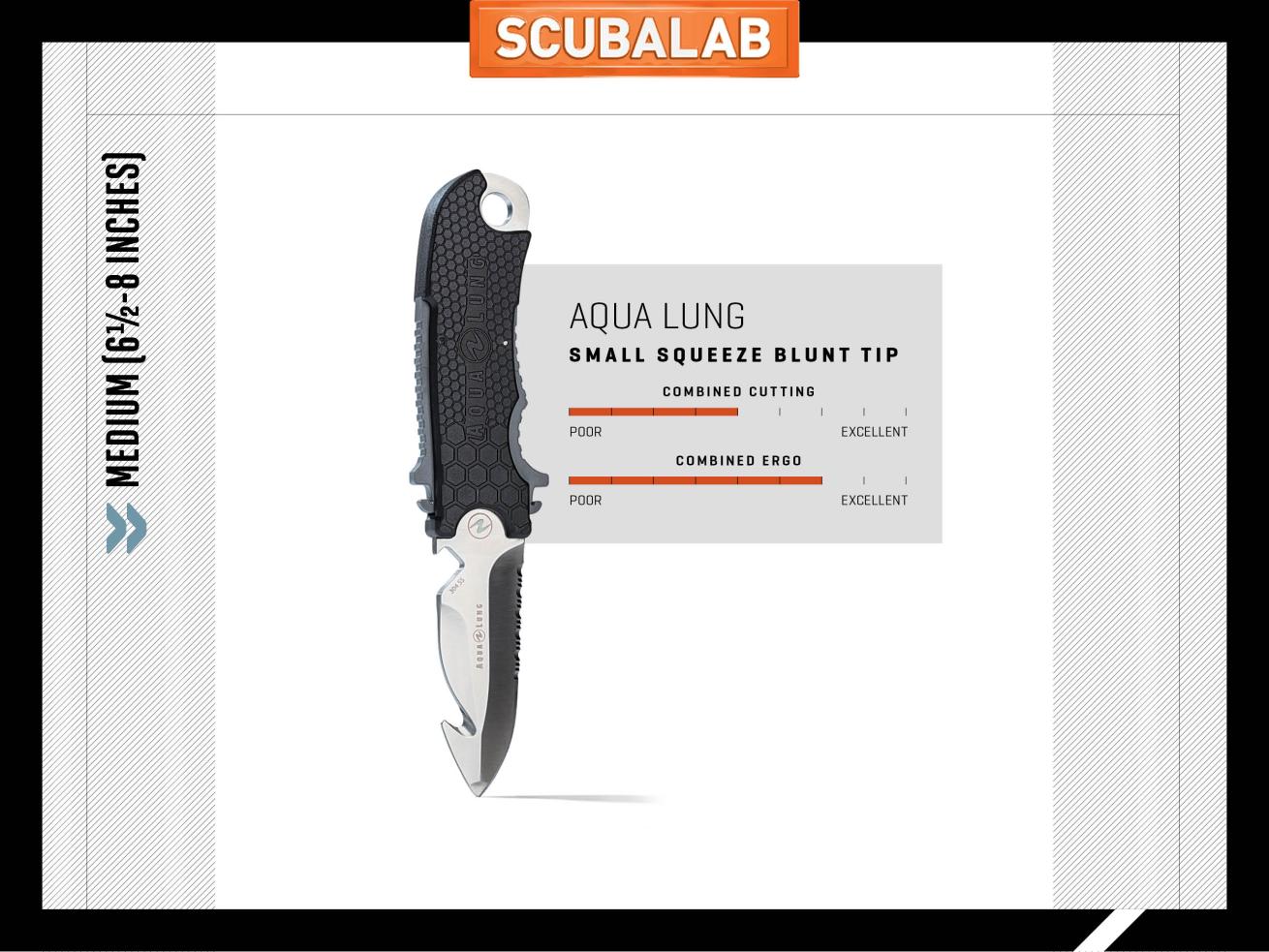
Jon WhittlePrice: $50 Contact: Aqua Lung
The middleweight Squeeze uses the same lock mechanism as the other Aqua Lung knives, but it has a grip and blade big enough to do some work while still compact enough to mount unobtrusively on a BC. The lock releases instantly with a pinch, and the knife positively will not fall out of the sheath until released. If you grip the knife with your thumb on the handle’s back, the lock tab is a bit uncomfortable barehanded (less so in the Small Squeeze than other sizes), but it still tied the top score in the category for its grip. The blunt-tip blade of 304 stainless was a decent cutter, able to saw through hard stuff and snip off wrapped monofilament with its line cutter with no unintentional cuts. After a 24-hour seawater soak, the only sign of corrosion was discoloration of the logo stamped on the blade.
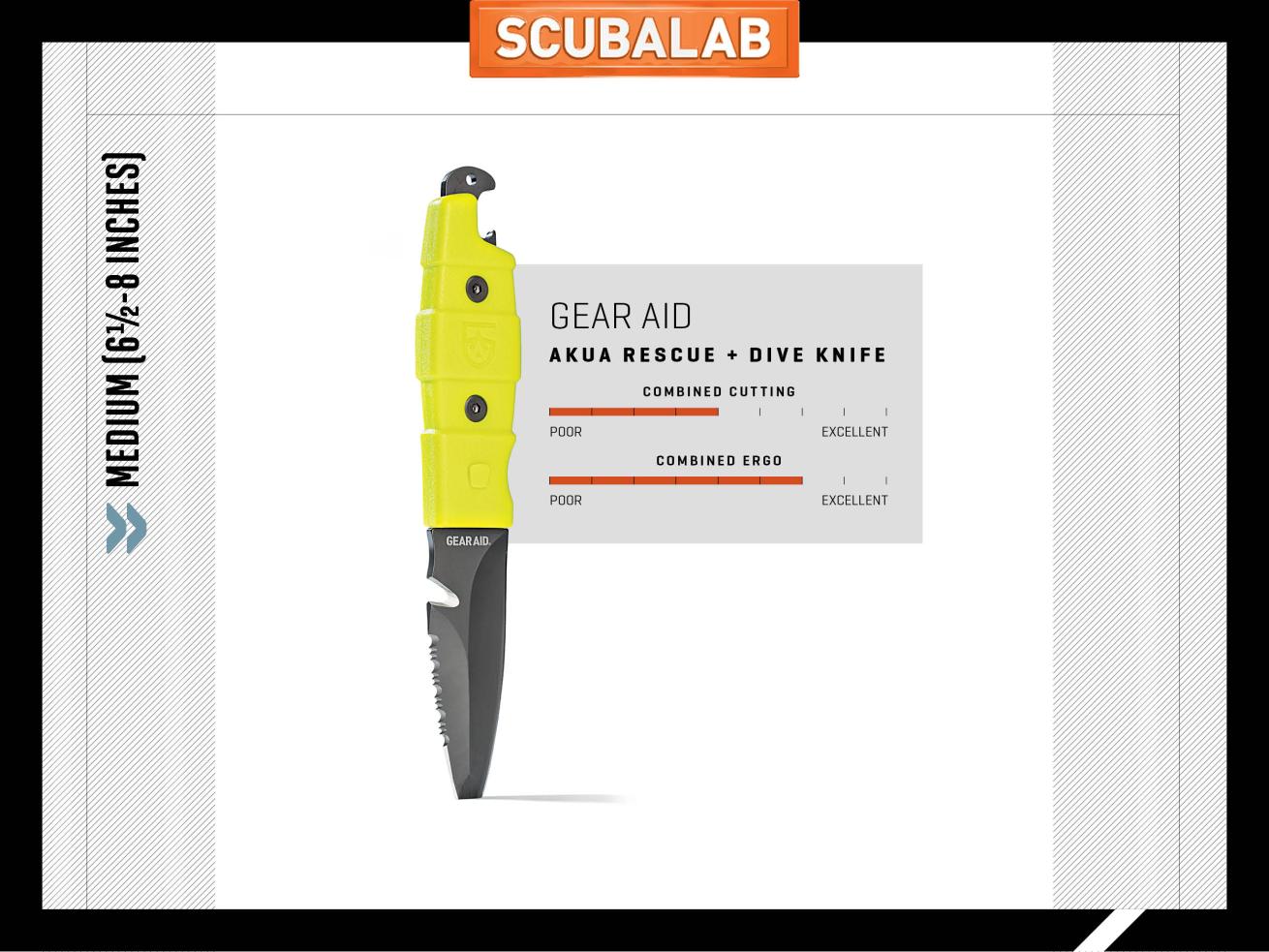
Jon WhittlePrice: $29.95 Contact: Gear Aid
The Akua has a Swiss Army-knife feel, with its smooth/serrated/line cutter/prying tip blade and bottle opener on the butt end, and it does a lot of things well. Its hollow-ground, full-tang 420 stainless blade saws aggressively for its size and lets you pry pretty hard without worries of breaking. The plastic sheath with a thumb release is secure and has several mounting options. The grip provides a secure enough hold, though no protection for fingers. The knife disassembles for cleaning, which it needs after being in seawater. While the blade’s titanium coating otherwise held off rust, the blade’s exposed cutting edges showed a fair amount of corrosion after a 24-hour saltwater dunk. But if you’re disciplined about thorough cleaning, the Akua is a useful, capable and inexpensive dive tool.
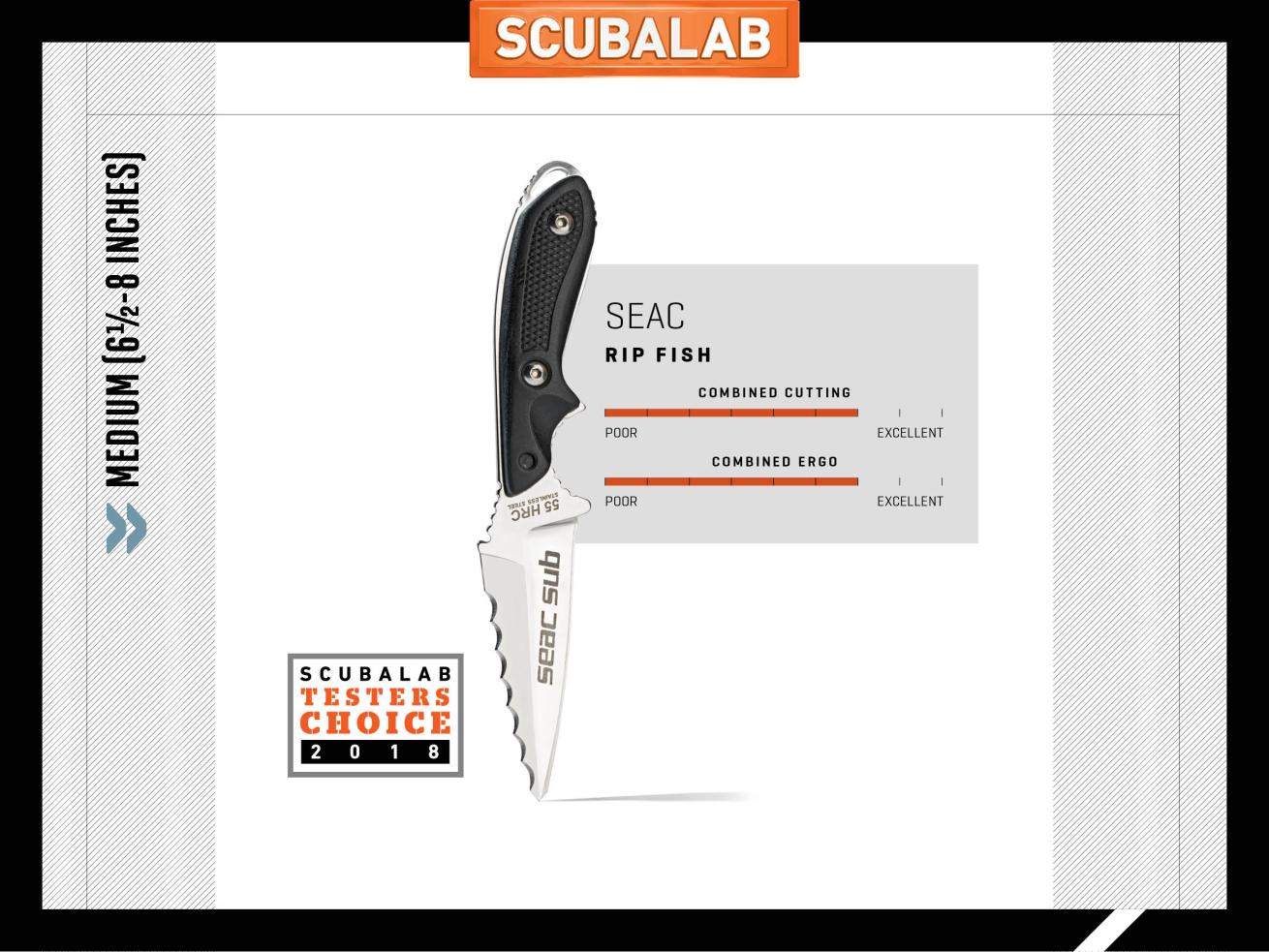
Jon WhittlePrice: $99 Contact: Seac
The Rip Fish’s 3½-inch blade shows its spearfishing orientation, but it is a capable all-around dive knife. It took the top combined cutting score in its category with its hollow-ground stainless edge that made short work of most of our test cuts. The thumb-lock sheath is secure and easy to use (less so left- handed), and the grip is good barehanded or gloved. Made of a highly polished, magnetic stainless, the knife had light corrosion spots after 24 hours in seawater, but they polished off. The serrated back edge isn’t any use for cutting because of the grip’s one-direction design. There’s also no line cutter, so cutting wrapped monofilament requires lots of care to avoid unwanted cuts. But the Rip Fish is a nicely made knife that was our Testers Choice for medium-size knives.
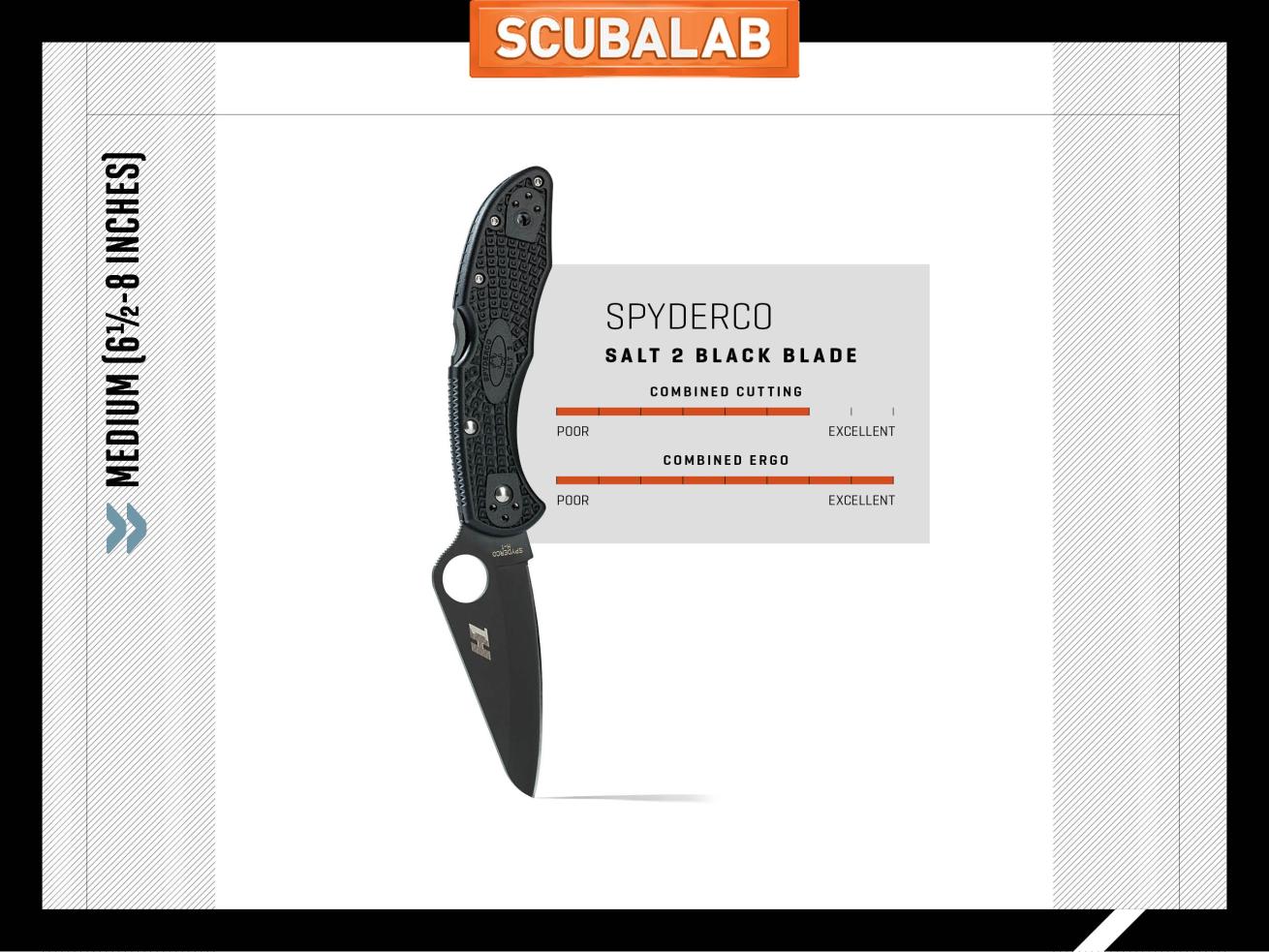
Jon WhittlePrice: $139.95 Contact: Spyderco
Its rustproof H1 steel blade appears identical to the earlier Salt 1 Lightweight (one of our favorites), but the Salt 2 has a fiberglass-reinforced nylon handle that’s a little longer and thicker for a more comfortable, secure grip, and you can mount the titanium pocket clip in four different positions. The large thumbhole makes it a snap to deploy the 3-inch blade (available with plain or serrated edge), and the back lock is as rock-solid as all the Spyderco folders we’ve used. The plain edge cut very well in all our test materials, though not quite as easily as serrated Spyderco blades. After 24 hours in salt water, the blade was spotless. The black handle and the blade’s titanium carbonitride coating give it a tactical look that’s cool, and it’s also available with a yellow handle and uncoated blade.
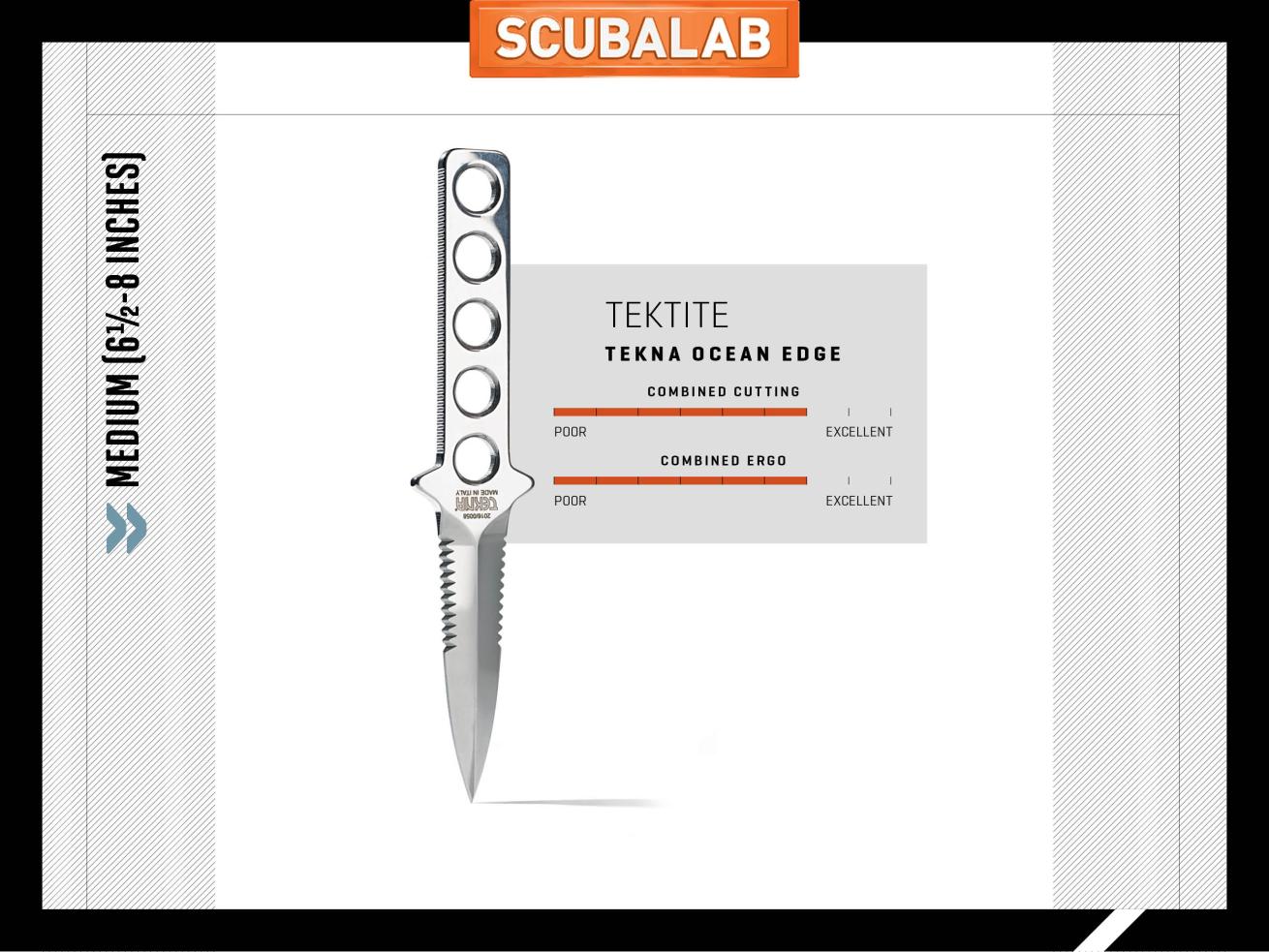
Jon WhittlePrice: $119.95 Contact: Tektite
Machined from a solid chunk of 420 HC stainless, the Ocean Edge has a dagger blade with two smooth/serrated edges that took above-average scores for cutting performance. Thick and strong, the blade stood up to heavy prying, and the knife has a hefty, well-made feel. The skeleton handle shares all the pros and cons of the design: ruggedness, simplicity and no place for rust to hide, but not necessarily the most comfortable grip. The spring-lock sheath is secure and the knife is easy to release, but when replacing it, take care to keep fingers away from the sharp edges. It’s also available with a blunt, hook-tip blade with a line cutter. Needing only a light cleanup after a long seawater soak, the Ocean Edge was among the more corrosion-resistant of the magnetic steel knives we tested.
COMPACT
UNDER 6.5 INCHES
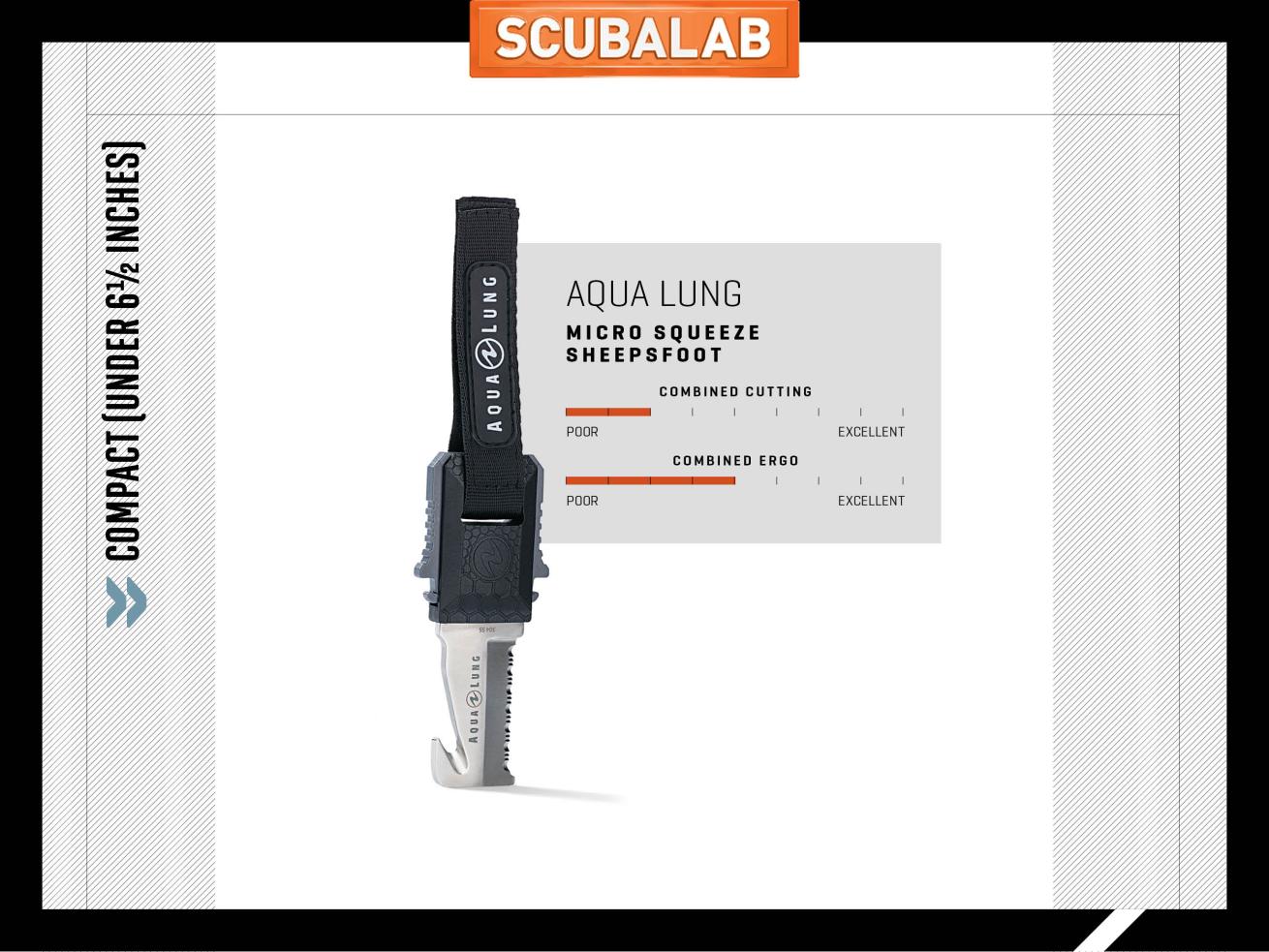
Jon WhittlePrice: $35 Contact: Aqua Lung
The Micro Squeeze’s serrated blade cuts well for its size, but what really impressed us was the unique locking mechanism. Simply squeeze the handle to release the knife from its sheath; it returns securely to a locked position with a reassuring click. The handle is just over 2 inches long, making it difficult to grasp, which was not helped by the uncomfortable raised ridges where the sheath lock hits. The Velcro strap gives some additional length to grip, but without a stop on the end to grasp, it doesn’t really alleviate the issue. The 304 stainless-steel blade is thick and sturdy, but its strength is undercut by the lack of a powerful grip to wield it. The Micro Squeeze did very well during our corrosion test and showed no sign of rust after 24 hours in salt water.
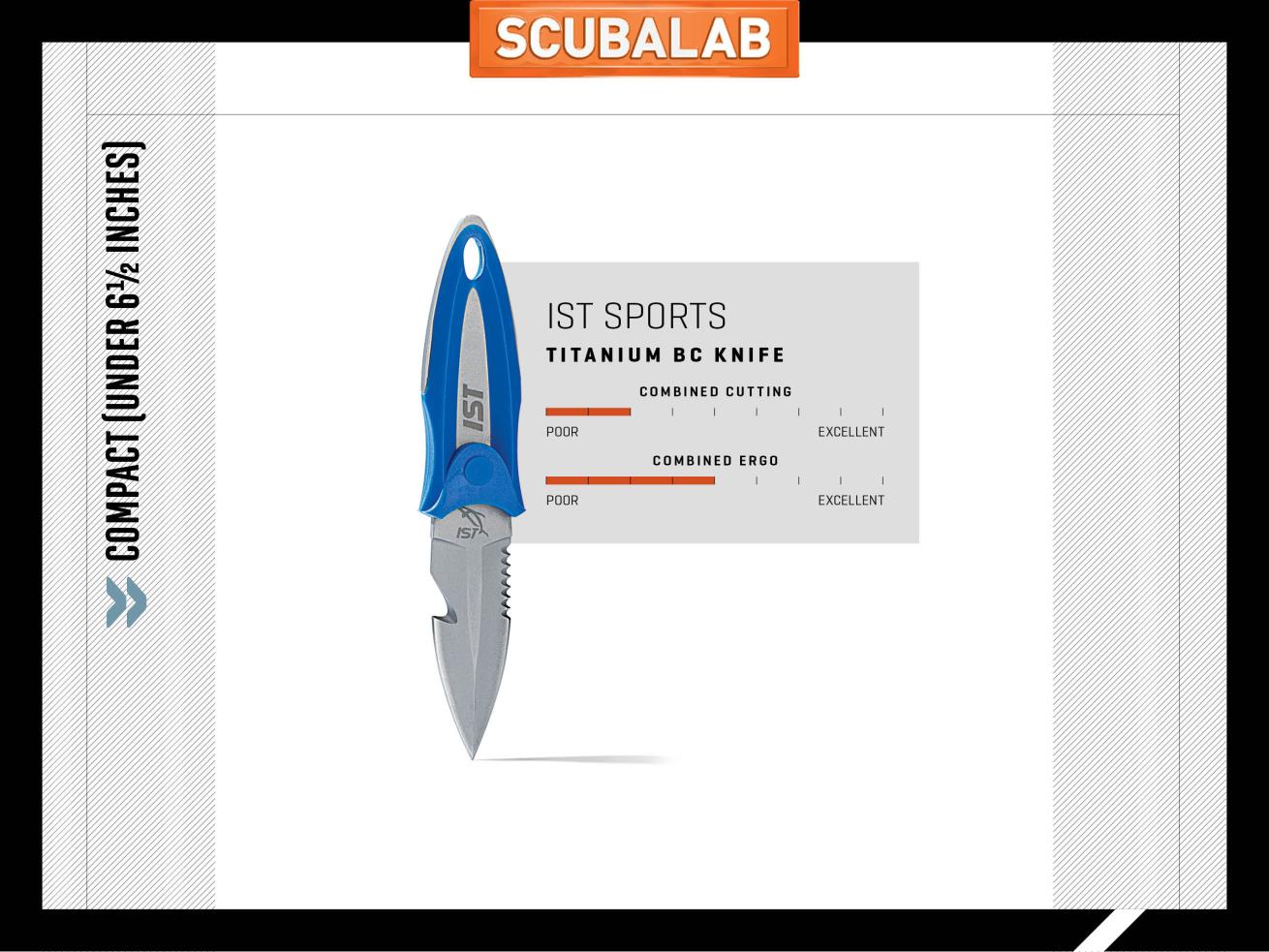
Jon WhittlePrice: $66 Contact: Ist Sports
The handle of the Titanium BC knife has a rubber coating that is more comfortable than its minimalist design would suggest. It doesn’t offer much in the way of a thumb guard, but it does provide an adequate grip while keeping weight to practically nothing (barely 1 ounce on our scale). The back edge of the knife is uncoated, which means you can use it as a tank banger. The smooth parts of the blade are short and curved, which might be ideal for sticking a fish but just won’t do heavy work. Line that avoids getting caught on the knife’s serrated edge or line cutter simply runs out of blade. The nylon sheath, which can be mounted to a BC shoulder strap or stored in a pocket, is fairly secure when the Velcro strap is pulled tight, but careless stowage could let the knife slip free.
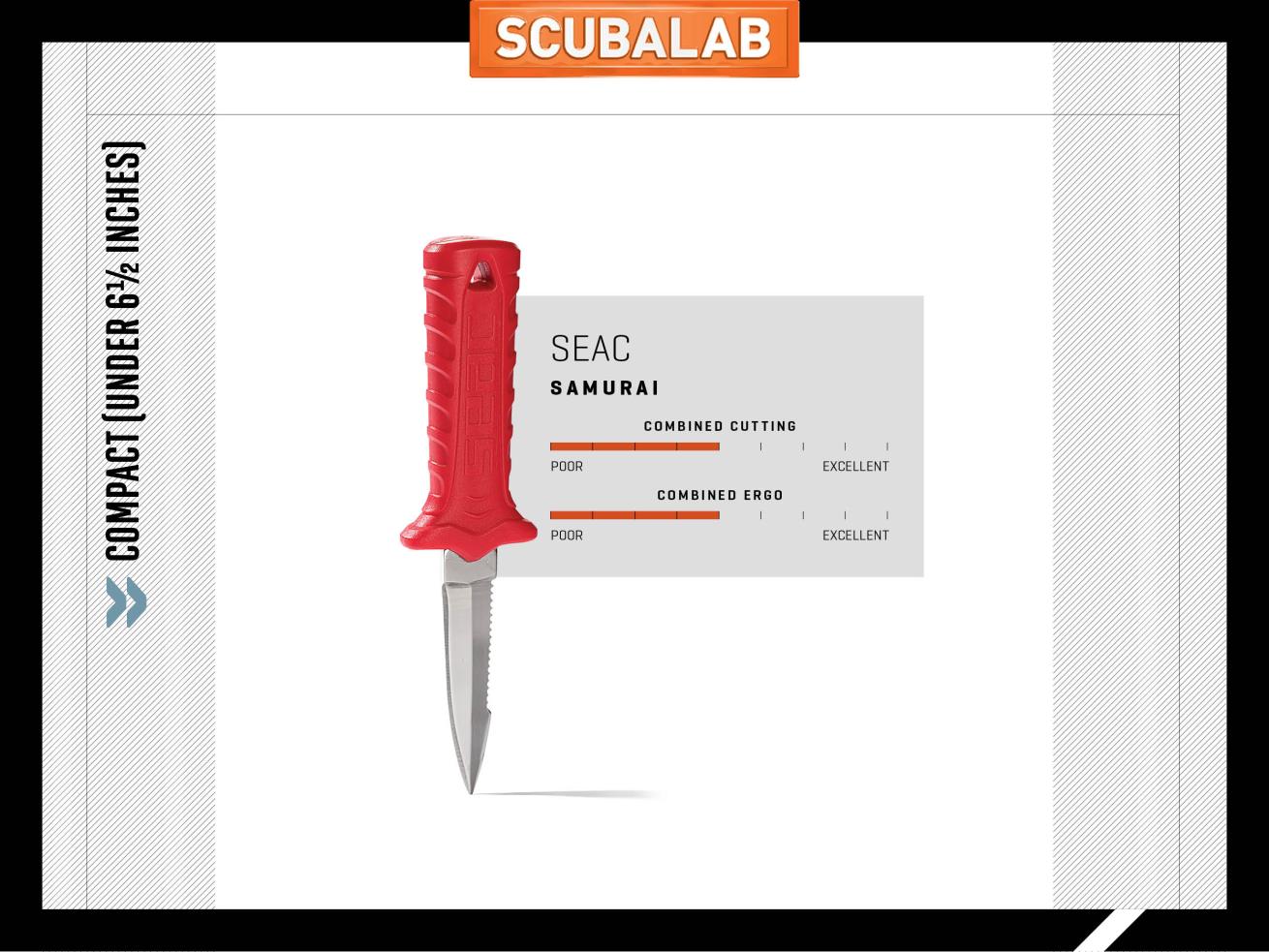
Jon WhittlePrice: $25 Contact: Seac
The least-expensive knife in our test, the Samurai delivered good performance. The stout, sturdy blade held up very well during our pry test and was, as one tester noted, “stiff as a screwdriver.” The knife is kept in the sheath by a rubber ring that slips over the handle. While removing the knife was a straightforward process, replacing it often required fussing with the ring, and when the ring is stretched tight, the knife can pull out. The Samurai had the second-highest cutting score in its category thanks to its serrated, stainless blade, but it also showed some rust after our saltwater soak, requiring a thorough cleaning to restore its shine. The handle, while unyieldingly hard, allows for a sturdy grip. This knife’s smooth blade lends itself more to spearfishing, but it can do the job of an all-around dive knife.
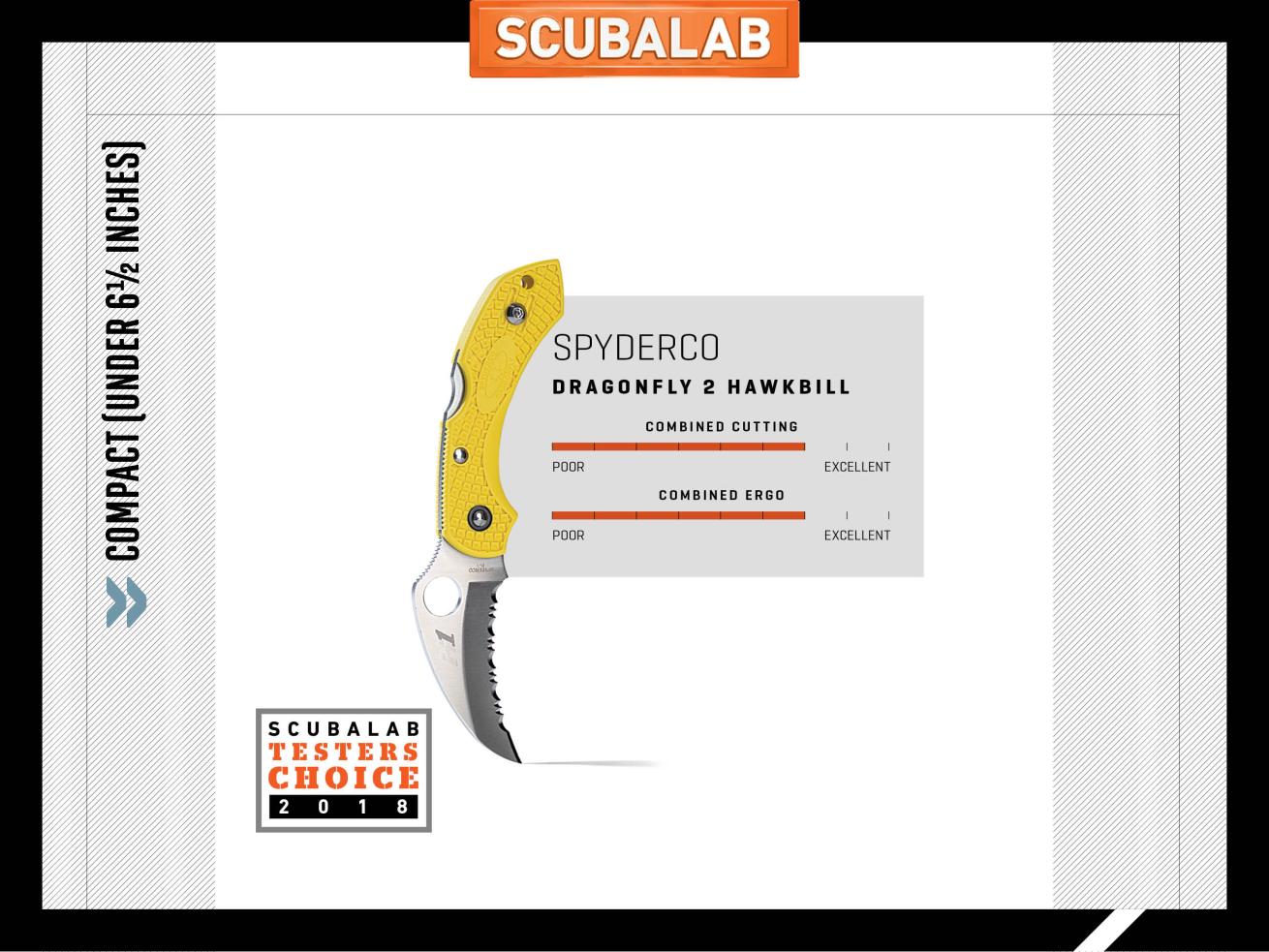
Jon WhittlePrice: $97.95 Contact: Spyderco
The Dragonfly 2 was the most expensive knife in its category, but it also earned the highest scores for cutting and ergonomics. The serrated blade made short work of our test lines — even the thick monofilament. Where other knives would bounce off the hard line, the Dragonfly’s hawkbill shape retains the line for the cut. The small handle doesn’t provide much to grip, but the blade cut so easily that it hardly mattered. The blade can be opened single-handedly, but it’s more difficult while wearing gloves due to its small size. The Dragonfly’s teeth are just visible when closed, but they are safely covered; the knife tied the top score for security of the sheath. After 24 hours in salt water, this knife's H1 steel was corrosion-free. The Dragonfly 2 is our Testers Choice for compact knives.
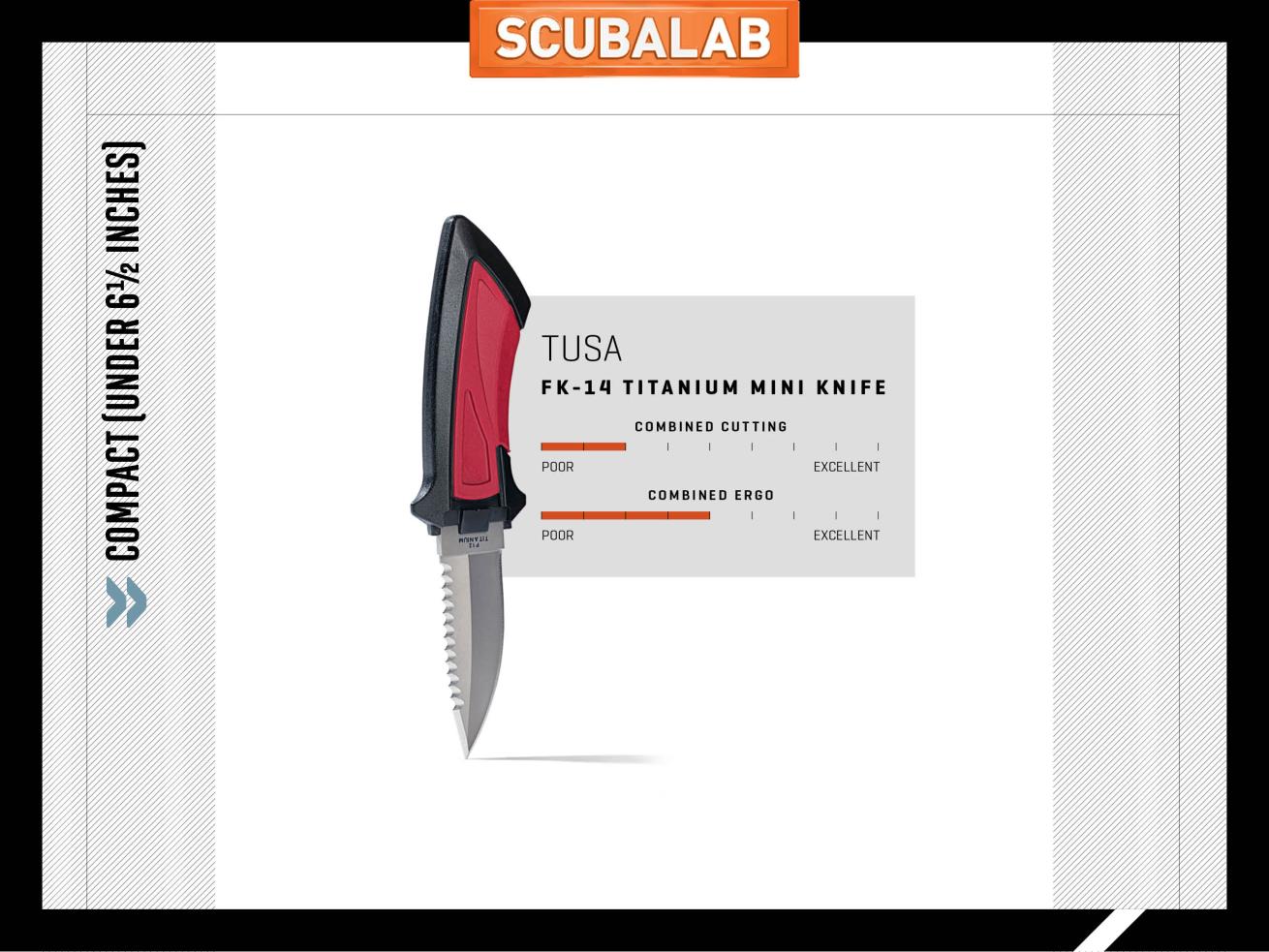
Jon WhittlePrice: $65 Contact: Tusa
The FK-14’s titanium blade features a smooth and serrated edge, and looked no worse for wear after being subjected to our 24-hour corrosion test. The handle offers a decent grip despite its small size, but after multiple hard cuts, the edges can begin to dig into your hand. The sheath’s locking mechanism can be a bit finicky, especially when replacing the knife. Unlocking it with one hand is tricky, and puts your fingers a little too close to the blade. The short length and curve of the drop-point blade limit its effectiveness, but it managed to get the third highest cutting score in its category. The knife was surprisingly strong during our pry test. Its size and weight make it a handy BC knife. It can easily fit in most BC pockets and also comes with a stainless steel clip and an inflator-hose adapter.
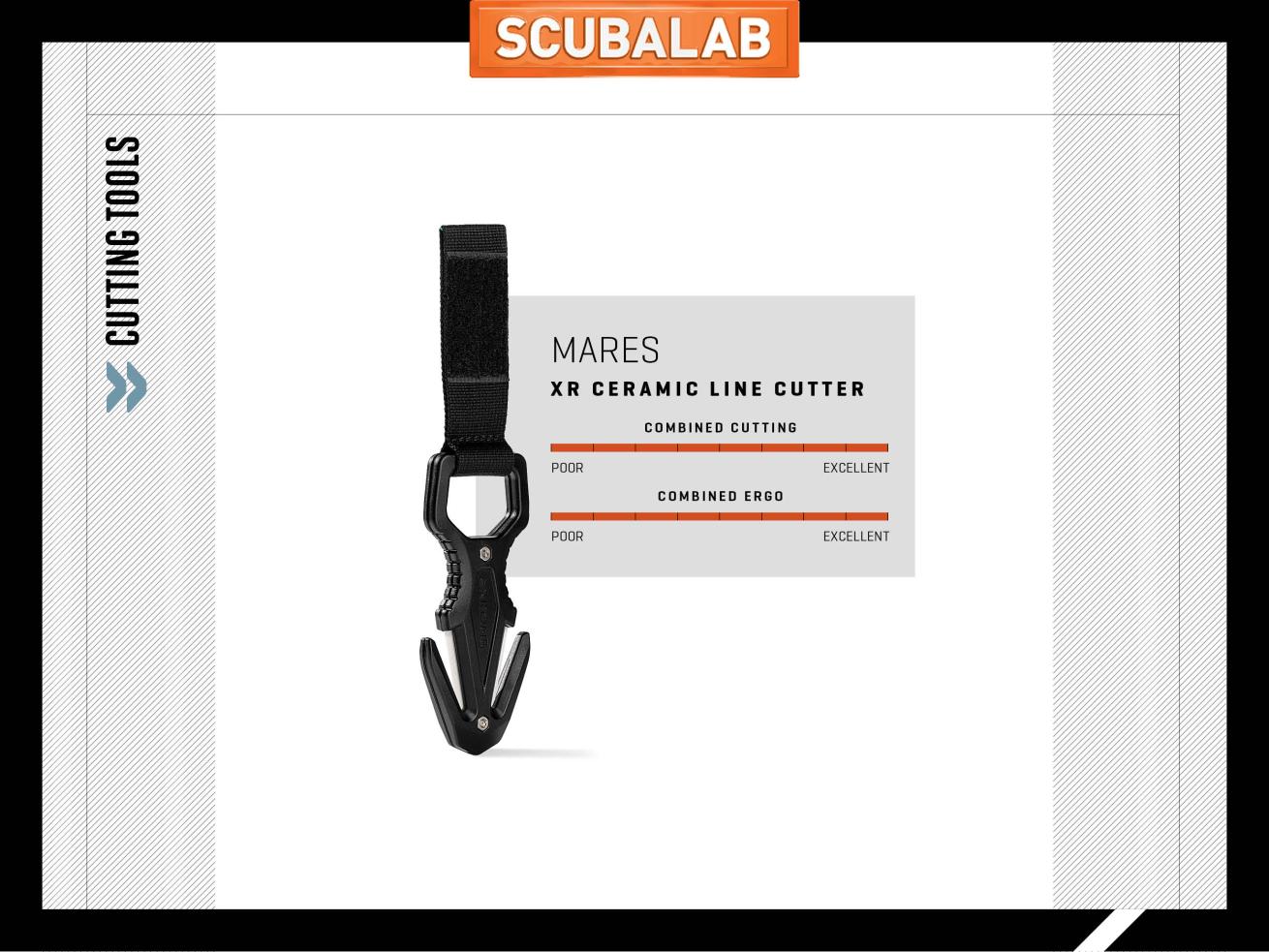
Jon WhittlePrice: $60 ceramic, $80 titanium Contact: Mares
We don’t usually award a Testers Choice in categories with no competition. But this little cutter was in a class of its own. Our gripe with traditional cutters has been rusting steel blades that require constant replacement. These ceramic blades won’t rust, and they are sharp, cutting with ease the heavy weed cutter line that stymied most of the knives in our test (this was the only tool to earn a perfect cutting score). So we tried cutting two lines at once: no problem. Then we did four, then six, then eight. The owner’s manual notes that ceramic blades aren’t made for cutting wire; still, we made dozens of wire cuts before we were finally able to break a blade. Low-maintenance and capable, the Ceramic Line Cutter was our Testers' Choice for cutting tools.

